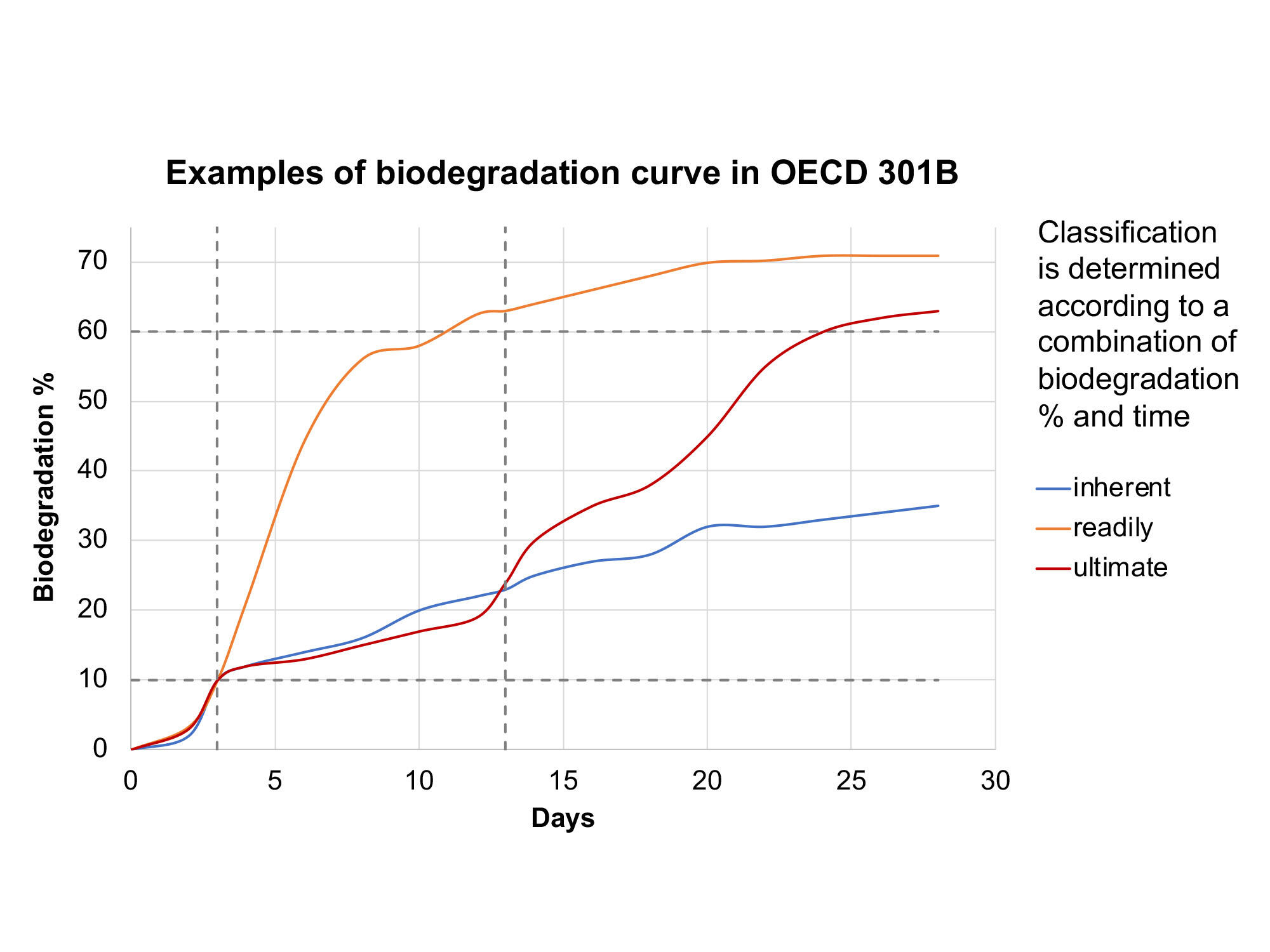Biodegradation: An Important Emerging Sustainability Concern
Many companies in our industry have sustainability goals relating to the biodegradability of their ingredients or formulas, demonstrating this topic's importance at the highest level. There are considerations in each ESG category (environmental, social, governance) related to biodegradability
Environment: Biodegradability is one key indicator that a substance has a benign or non-harmful impact on the environment at end of life. Sourcing biodegradable materials can help reduce the impact our formulas have on the environment once they are washed down the drain.
Social: Consumers are starting to see biodegradability as a important attribute and indicator of a company's values. Biodegradability claims are emerging in many related consumer goods areas such as disposable packaging, textiles, and home goods.
Governance: Biodegradation is factored into environmental regulations, such as chemical designations by ECHA. For example, substances designated as PBT (Persistent, Bioaccumulative, and Toxic) or vPvB (very Persistent, very Bioaccumulative) are restricted to certain percentages or subject to authorization for specific uses.
Abiotic or Biotic Degradation?
Biodegradation, also known as biotic degradation, is one of the two types of degradation. Explore the graphic below to review the definitions.

How Does Aerobic Biodegradation Work?
Aerobic biodegradation is the process by which a substance is broken down by oxygen and microorganisms. The "completeness" to which the substance is broken down determines its potential environmental impact and biodegradation status.
A substance can be broken down into simpler structures, which is known as primary biodegradation. Those simpler structures may or may not be benign to the environment and further analysis of their impact must be determined. On the other hand, a substance can biodegrade completely which means that the resulting compounds are not just simpler structures but are specifically broken down into CO2, H2O and biomass and are essentially benign to the environment. When a substance has biodegraded completely into these structures it is known as mineralization.

What are the environmental impacts of non-biodegradable substances?
If a substance is not biodegradable, there is a risk that it will be persistent, bioaccumulative and toxic to the environment. This is best explained through a series of if/then circumstances starting with a lack of biodegradation.
- If there is no biodegradation, then it is more likely that a chemical will persist in the environment.
- If there is persistence, then a chemical is remaining in the environment unchanged for a long period of time and has the potential to accumulate.
- If the chemical accumulates, then there is a potential that it will be toxic.
Remember, toxicity is a function of concentration. So persistent, accumulating substances can present toxicity to the environment and organisms.
Q&A on Microplastics
A microplastic is a solid, non-biodegradable substance typically with a particle size smaller than 5 mm. Microplastics are building up in our waterways, oceans, and aquatic life. The build up of these particles are causing harm to aquatic organisms and ecosystems.
The criteria to being defined as a ‘microplastic’ is still in the process of being determined by different organizations and regulating bodies. Some microplastics have already been banned or restricted (example – microbeads in the US or PBTs in the EU) but widespread regulation for all microplastics has not been implemented.
Formulating with biodegradable substances is an important step to eliminating microplastics from cosmetic formulations. If a substance biodegrades, it does not have the same negative environmental impacts as non-biodegradable plastics do.
Biodegradation Testing
Biodegradation is an inherent property of an organic compound (a chemical compound containing carbon-hydrogen bonds). It can be identified through testing for a singular substance but NOT for mixtures. Standardized tests by organizations such as OECD, ASTM, and ISO are used to evaluate the biodegradability of a chemical.
Biodegradability is assessed by the completeness and speed in which the substance biodegrades and classification is determined accordingly.

Q&A on Biodegradation Testing
The OECD outlines a methodology for testing biodegradability that is widely accepted, industry-standard, and is the most developed and comprehensive. The process for testing biodegradation is very nuanced and more information can be found directly on the OECD website. There are a range of tests which have different conditions and the results are determined by the speed and completeness in which a substance biodegrades.
Some commonly used OECD tests in our industry include OECD 301 (Tests A-F) and OECD 302 (A-C).
The following example is a typical process we would undergo in order to determine a chemical's biodegradability. First, the substance is tested for ready biodegradability via OECD 301. The conditions of these tests are stringent, making it difficult to biodegrade. The substance is evaluated for its speed and completeness of biodegradation. Possible results of the test include:
- Biodegrades fast and completely → classification of readily biodegradable
- Biodegrades completely but not fast enough → results can be interpreted to indicate a likely ultimate biodegradation status
- Does not biodegrade fast enough or completely → not readily biodegradable
If a substance does not meet the criteria for readily biodegradable, we could move on to test it under OECD 302 which evaluates inherent biodegradation. The conditions of this test are more conducive to biodegradation. Possible results of the test are:
- At least 20% biodegradable → classification of inherent, primary biodegradation
- At least 70% biodegradation → classification of inherent, ultimate biodegradation
- Less than 20% biodegradable → not biodegradable
Biodegradation is an inherent property of a chemical compound. Today, there is no standard test for assessing biodegradation of mixtures or cosmetic formulations. Instead, there are theoretical models and methods for determining the status.
Making Biodegradation Claims on Formulas
Since biodegradation tests (including the OECD tests) only apply to individual substances, scientists have developed some theoretical methods for evaluating the biodegradation status of mixtures which relates to formulations. Using these approaches, we can identify the impact our formulations might have on the environment. All of these approaches start with identifying the biodegradability of the ingredients in a formula.
Approach 1: Source only verified biodegradable ingredients
Approach 2: Theorize based on chemical structure and properties and biodegradation status of the ingredients
Approach 3: Calculate biodegradation status based on biodegradation status of ingredients
Example of Valid, Verified Biodegradation Claim
Unilever's Love Beauty & Planet brand, makes a "100% biodegradable formula" claim by using approach #1 referenced above which refers to ingredient biodegradability according to OECD 301, 302, 310 tests. This example demonstrates a reputable and transparent way to make a biodegradability claim on a finished product.

Going Biodegradable
Replacing legacy ingredients with high performance sustainable technologies is a great way to improve the biodegradability of your formula.
Replacing legacy ingredients with high performance sustainable technologies is a great way to improve the biodegradability of your formula.
Film Formers
Many film formers used in sun care, hair care, skincare, and color cosmetics are not biodegradable. INOLEX's 'BFF' platform of biodegradable film formers brings environmentally conscious performance to your water-resistant sun care and more.
Silicone Alternatives
Replace silicones with sustainable alternatives. Although silicones degrade over long periods of time, they are not readily biodegradable - meaning that they aren't breaking down fast enough in the environment's natural processes.
Non-Quat Cationics
Polyquats are widely-used high performance conditioning agents, but some have environmental concerns and should be phased out. Non-quat cationics from INOLEX yield comparable performance with superior sustainability profiles and can replace non-biodegradable conditioning agents.
A Biodegradable Portfolio – Low Environmental Impact of Inolex Ingredients
98% of the ingredients in Inolex's portfolio have been verified as biodegradable through an OECD test or one of the 3 approaches for determining biodegradability of a mixture.
You can search for biodegradable products by using our product filter and selecting 'biodegradable' under the Standards & Certifications category.
Use our Product Selection Tool and select Standards & Certifications to discover Inolex ingredients that are biodegradable:
Featured Biodegradable Ingredients
LexFilm™ Sun Natural MB
100% Plant-Based, Biodegradable Film Former- 100% plant-based polymer
- COSMOS approved
- Optimize SPF & create water resistance
- Readily biodegradable
- Compatible with inorganic & organic UV filters
AminoSensyl™ HC
100% Natural Quat-Free Hair Care System- Multi-benefit hair conditioning system
- 100% natural & COSMOS approved
- Cationic amino lipid technology
- Smooth, define, and strengthen hair
Related Articles

Inolex Presents: Freedom to Formulate Ultra Light and Natural Sun Care
Webinar AlertFormulating Sun Care isn't easy, but LexFeel® SunLight MB makes it easier to create light, effective
mineral dispersions.

The Bright Future of Sun Care
Webinar AlertSun care is evolving into a lifestyle segment of Solar Beauty, an emerging category that incorporates multifunctionality and sensoriality. This on-demand webinar takes us through why sensoriality is an essential component of beauty care today.

Why Biodegradability Is the Beauty Industry's Next Big Shift
In a recent article for Cosmetics Magazine, Luca Phillips explores how growing demand for sustainable beauty is driving innovation in biodegradable ingredients—and why transparency in formulation is becoming essential for brands navigating this shift.

